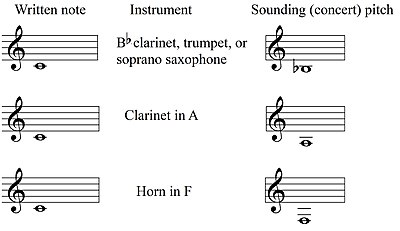
A transposing instrument is a musical instrument for which music notation is not written at concert pitch (concert pitch is the pitch on a non-transposing instrument such as the piano). For example, playing a written middle C on a transposing instrument produces a pitch other than middle C; that sounding pitch identifies the interval of transposition when describing the instrument. Playing a written C on clarinet or soprano saxophone produces a concert B♭ (i.e. B♭ at concert pitch), so these are referred to as B♭ instruments. Providing transposed music for these instruments is a convention of musical notation. The instruments do not transpose the music; rather, their music is written at a transposed pitch. Where chords are indicated for improvisation they are also written in the appropriate transposed form.
For some instruments, a written C sounds as a C but is in a different octave; these instruments are said to transpose "at the octave". Pitches on the double bass sound an octave lower than written, while those on the piccolo and celesta sound an octave higher, and those on the glockenspiel sound two octaves higher.